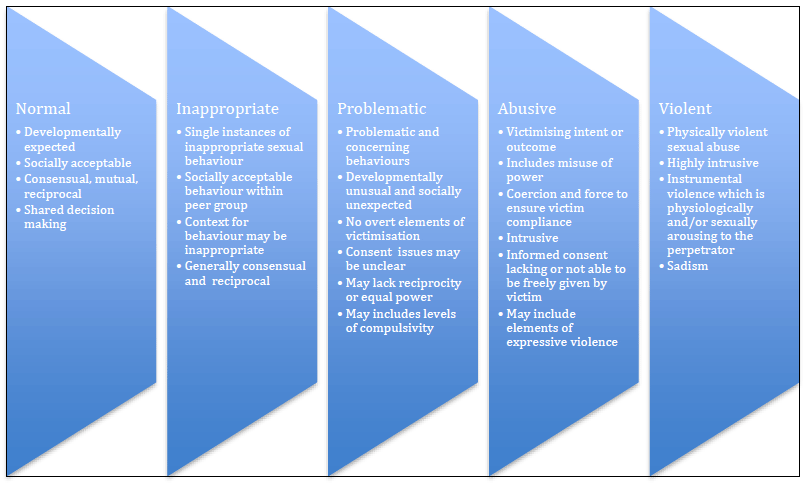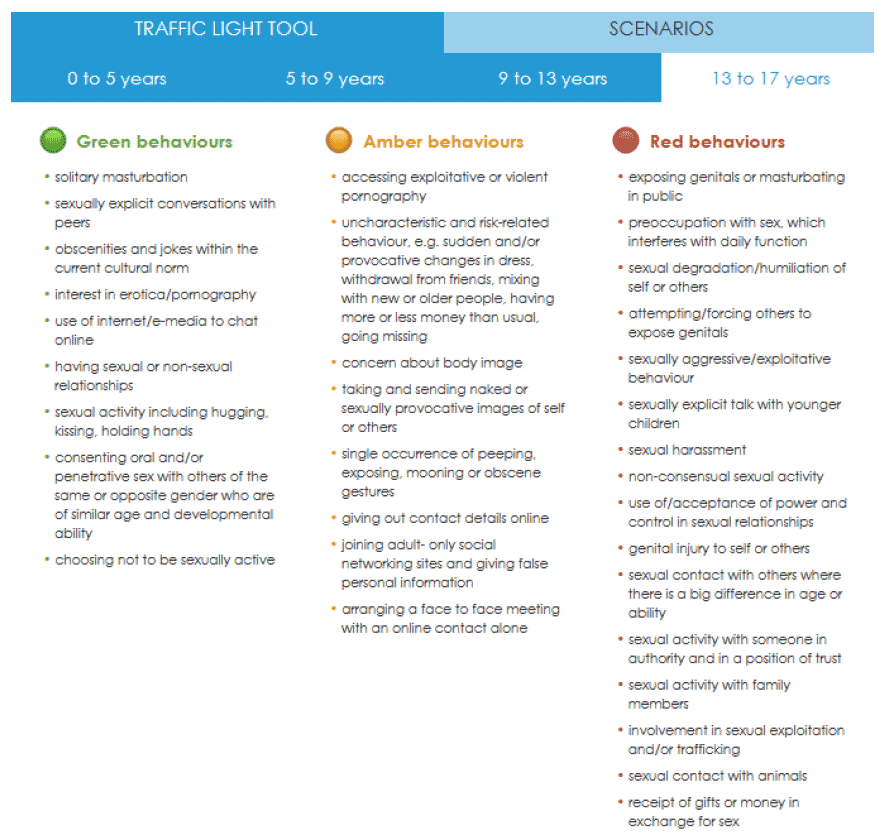Harmful sexual behaviour by children and young people: Expert Group report
This report sets out proposals from the Expert Group on Preventing Sexual Offending Involving Children and Young People to improve prevention and early intervention in response to harmful sexual behaviour involving children and young people.
Chapter 3: The Nature of Harmful Sexual Behaviours (HSB)
A Continuum of Behaviours
The following diagram comes from the work of Professor Simon Hackett and illustrates the continuum of sexual behaviour.
Diagram - A continuum of children and young people's sexual behaviours (Hackett, 2010)
Infographic:

Infographic text:
Normal
- Developmentally expected
- Socially acceptable
- Consensual, mutual, reciprocal
- Shared decision making
Inappropriate
- Single instances of inappropriate sexual behaviour
- Socially acceptable behaviour within peer group
- Context for behaviour may be inappropriate
- Generally consensual and reciprocal
Problematic
- Problematic and concerning behaviours
- Developmentally unusual and socially unexpected
- No overt elements of victimisation
- Consent issues may be unclear
- May lack reciprocity or equal power
- May includes levels of compulsivity
Abusive
- Victimising intent or outcome
- Includes misuse of power
- Coercion and force to ensure victim compliance
- Intrusive
- Informed consent lacking or not able to be freely given by victim
- May include elements of expressive violence
Violent
- Physically violent sexual abuse
- Highly intrusive
- Instrumental violence which is physiologically and/or sexually arousing to the perpetrator
- Sadism
Distinguishing between appropriate non-abusive behaviour and inappropriate or abusive behaviour can be a complex task that requires practitioners to have an understanding of what is healthy and informed consent and what is abusive or coercive.[34]
There is a range of common and healthy behaviours at different developmental stages. When a child or young person behaves in ways considered to be outside this range, their behaviour may be called 'harmful' because it is harmful to themselves or others.
The Brook Sexual Behaviours Traffic Light Tool[35] offers guidance for age-appropriate behaviour. The following diagram is part of a screenshot from the Brooks Traffic Light Tool, and shows behaviours for a young person aged 13-17 that fall within green, amber and red categories:
Infographic:

Infographic text:
Green behaviours
- solitary masturbation
- sexually explicit conversations with peers
- obscenities and jokes within the current cultural norm
- interest in erotica/pornography
- use of internet/e-media to chat online
- having sexual or non-sexual relationships
- sexual activity including hugging, kissing, holding hands
- consenting oral and/or penetrative sex with others of the same or opposite gender who are of similar age and developmental ability
- choosing not to be sexually active
Amber behaviours
- accessing exploitative or violent pornography
- uncharacteristic and risk-related behaviour, e.g. sudden and/or provocative changes in dress, withdrawal from friends, mixing with new or older people, having more or less money than usual, going missing
- concern about body image
- taking and sending naked or sexually provocative images of self or others
- single occurrence of peeping, exposing, mooning or obscene gestures
- giving out contact details online
- joining adult- only social networking sites and giving false personal information
- arranging a face to face meeting with an online contact alone
Red behaviours
- exposing genitals or masturbating in public
- preoccupation with sex, which interferes with daily function
- sexual degradation/humiliation of self or others
- attempting/forcing others to expose genitals
- sexually aggressive/exploitative behaviour
- sexually explicit talk with younger children
- sexual harassment
- non-consensual sexual activity
- use of/acceptance of power and control in sexual relationships
- genital injury to self or others
- sexual contact with others where there is a big difference in age or ability
- sexual activity with someone in authority and in a position of trust
- sexual activity with family members
- involvement in sexual exploitation and/or trafficking
- sexual contact with animals
- receipt of gifts or money in exchange for sex
The Brook Traffic Light Tool was recently evaluated in relation to its applicability in a UK context.[36] The evaluation concluded that UK practitioners found the tool helpful but, as it was developed in Australia, there are some cultural context issues in its applicability in a UK setting.
Expert Group Findings and Conclusions
Agreement on an expression of a continuum of behaviours, and examples of the differences between normal and HSB would help inform front line professionals working directly with children and young people, as well as parents and carers.
An essential element of any Primary Prevention approach is to ensure that society is educated about and is aware of risks and responses - in this instance around the range of sexual behaviours that are developmentally normal for children and young people - and how to react when the behaviours are concerning.
The Hackett Continuum and the Brook Traffic Light Tool are useful aids to ensure a shared understanding among practitioners who engage with children and young people, and their parents and carers.
Expert Group Proposals
All relevant guidance for professionals working with children and young people in statutory authorities, and third sector organisations involved in the delivery of their services, should make reference to the Hackett Continuum and the Brook Traffic Light Tool
All relevant guidance published for use by parents and carers should make reference to the Hackett Continuum and the Brook Traffic Light Tool.
The Brook Traffic Light Tool should be revised and adapted into a version specifically for use in Scotland.
Contact
Email: Child_Protection@gov.scot
There is a problem
Thanks for your feedback